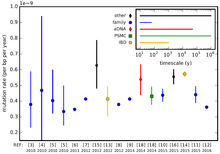
Back Mutacijska stopa BS Tasa de mutación Spanish Mutatsioonimäär ET آهنگ جهش FA Mutaatiotaajuus Finnish Taux de mutation French Taxa de mutación GL Tasso di mutazione Italian 돌연변이율 Korean Стапка на мутација MK

In genetics, the mutation rate is the frequency of new mutations in a single gene, nucleotide sequence, or organism over time.[2] Mutation rates are not constant and are not limited to a single type of mutation; there are many different types of mutations. Mutation rates are given for specific classes of mutations. Point mutations are a class of mutations which are changes to a single base. Missense, nonsense, and synonymous mutations are three subtypes of point mutations. The rate of these types of substitutions can be further subdivided into a mutation spectrum which describes the influence of the genetic context on the mutation rate.[3]
There are several natural units of time for each of these rates, with rates being characterized either as mutations per base pair per cell division, per gene per generation, or per genome per generation. The mutation rate of an organism is an evolved characteristic and is strongly influenced by the genetics of each organism, in addition to strong influence from the environment. The upper and lower limits to which mutation rates can evolve is the subject of ongoing investigation. However, the mutation rate does vary over the genome.[4]
When the mutation rate in humans increases certain health risks can occur, for example, cancer and other hereditary diseases. Having knowledge of mutation rates is vital to understanding the future of cancers and many hereditary diseases.[5]
- ^ Scally A (December 2016). "The mutation rate in human evolution and demographic inference". Current Opinion in Genetics & Development. 41: 36–43. doi:10.1016/j.gde.2016.07.008. PMID 27589081. Archived from the original on 2021-01-02. Retrieved 2020-09-08.
- ^ Crow JF (August 1997). "The high spontaneous mutation rate: is it a health risk?". Proceedings of the National Academy of Sciences of the United States of America. 94 (16): 8380–8386. Bibcode:1997PNAS...94.8380C. doi:10.1073/pnas.94.16.8380. PMC 33757. PMID 9237985.
- ^ Pope CF, O'Sullivan DM, McHugh TD, Gillespie SH (April 2008). "A practical guide to measuring mutation rates in antibiotic resistance". Antimicrobial Agents and Chemotherapy. 52 (4): 1209–1214. doi:10.1128/AAC.01152-07. PMC 2292516. PMID 18250188.
- ^ Moxon ER, Rainey PB, Nowak MA, Lenski RE (January 1994). "Adaptive evolution of highly mutable loci in pathogenic bacteria". Current Biology. 4 (1): 24–33. Bibcode:1994CBio....4...24M. doi:10.1016/s0960-9822(00)00005-1. PMID 7922307.
- ^ Tomlinson IP, Novelli MR, Bodmer WF (December 1996). "The mutation rate and cancer". Proceedings of the National Academy of Sciences of the United States of America. 93 (25): 14800–14803. Bibcode:1996PNAS...9314800T. doi:10.1073/pnas.93.25.14800. PMC 26216. PMID 8962135.